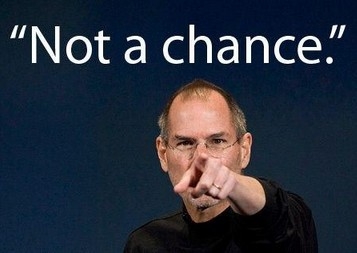Animation
動畫
The digital animation business at Pixar—the group that made little animated films—was originally just a sideline, its main purpose being to show off the hardware and software of the company. It was run by John Lasseter, a man whose childlike face and demeanor masked an artistic perfectionism that rivaled that of Jobs. Born in Hollywood, Lasseter grew up loving Saturday morning cartoon shows. In ninth grade, he wrote a report on the history of Disney Studios, and he decided then how he wished to spend his life.
皮克斯的數字動畫業務——制作動畫短片的團隊——最初只是副業,其主要目的是對外展示自己的硬件和軟件,約翰·拉塞特負責這個團隊的運作,他有著可愛的臉龐和氣質,對于藝術的完美追求與喬布斯不相上下。拉塞特出生在好萊塢,從小就喜歡觀看周六早間的卡通節目。九年級時,讀完記述迪士尼工作室歷史的《動畫的藝術》(TheArtofAnimation)后,他寫了一份讀書報告,那時的他就明白了自己想要怎樣度過一生。
When he graduated from high school, Lasseter enrolled in the animation program at the California Institute of the Arts, founded by Walt Disney. In his summers and spare time, he researched the Disney archives and worked as a guide on the Jungle Cruise ride at Disneyland. The latter experience taught him the value of timing and pacing in telling a story, an important but difficult concept to master when creating, frame by frame, animated footage. He won the Student Academy Award for the short he made in his junior year, Lady and the Lamp, which showed his debt to Disney films and foreshadowed his signature talent for infusing inanimate objects such as lamps with human personalities. After graduation he took the job for which he was destined: as an animator at Disney Studios.
髙中畢業后,拉塞特進入了由沃爾特·迪士尼創辦的加州藝術學院(CaliforniaInstituteoftheArts),學習動畫專業。暑假和課余時間,他研究迪士尼的檔案文件,還在迪士尼樂園的叢林巡航游樂項目做導游。迪士尼樂園的導游經歷讓他懂得了把握時間和節奏對于講故事的重要性,在創作一幀一幀的動畫時,掌握這一概念很重要但也絕非易事。拉塞特大學三年級時拍攝的短片《小姐與臺燈》(LadyandtheLamp)為他贏得了學生奧斯卡獎(StudentAcademyAward)。這部短片借鑒了《小姐與流浪漢》(LadyandtheTramp)等迪士尼電影,也展露出他的驚人天才——賦予無生命的東西以人的個性。畢業后,他得到了一份注定要從事的工作——在迪士尼制片廠(DisneyStudio)做動畫師。
Except it didn’t work out. “Some of us younger guys wanted to bring Star Wars–level quality to the art of animation, but we were held in check,” Lasseter recalled. “I got disillusioned, then I got caught in a feud between two bosses, and the head animation guy fired me.” So in 1984 Ed Catmull and Alvy Ray Smith were able to recruit him to work where Star Wars–level quality was being defined, Lucasfilm. It was not certain that George Lucas, already worried about the cost of his computer division, would really approve of hiring a full-time animator, so Lasseter was given the title “interface designer.”
但是拉塞特在迪士尼的工作并不順心。“我們一些年輕人想要給動畫藝術帶來《星球大戰》的水準,但卻受到了約束。”拉塞特回憶說,“我的幻想破滅了,后來卷入了兩個上司之間的斗法,動畫部門的頭兒解雇了我。”1984年,埃德·卡特穆爾和阿爾維·雷·史密斯聘請了拉塞特,而《星球大戰》的水準正是出自盧卡斯影業。當時,喬治·盧卡斯就已經在擔憂電腦部門的成本了,他們拿不準盧卡斯是否會同意雇用一位全職動畫師,因而拉塞特的職位是“界面設計師”。
After Jobs came onto the scene, he and Lasseter began to share their passion for graphic design. “I was the only guy at Pixar who was an artist, so I bonded with Steve over his design sense,” Lasseter said. He was a gregarious, playful, and huggable man who wore flowery Hawaiian shirts, kept his office cluttered with vintage toys, and loved cheeseburgers. Jobs was a prickly, whip-thin vegetarian who favored austere and uncluttered surroundings. But they were actually well-suited for each other. Lasseter was an artist, so Jobs treated him deferentially, and Lasseter viewed Jobs, correctly, as a patron who could appreciate artistry and knew how it could be interwoven with technology and commerce.
喬布斯入主公司后,拉塞特和他開始分享彼此對于圖形設計的激情。“我在皮克斯是唯一一個藝術家,因此和史蒂夫在設計感覺上有很大共鳴。”拉塞特說道。他合群,好玩,討人喜歡,愛穿花哨的夏威夷衫,辦公室里堆滿古董玩具,喜歡吃芝士漢堡包。喬布斯易怒,是個身形痩削的素食主義者,喜歡簡樸整潔的環境。但他們竟然非常契合。拉塞特是個藝術家,而藝術家在喬布斯眼里不是英雄就是笨蛋,拉塞特在他眼里顯然屬于英雄那一類。喬布斯對他恭敬有加,真心欽佩他的才華。拉塞特則理智地將喬布斯視做贊助人——能夠欣賞藝術工作并且知道如何將其與技術和商業進行融合。
Jobs and Catmull decided that, in order to show off their hardware and software, Lasseter should produce another short animated film in 1986 for SIGGRAPH, the annual computer graphics conference. At the time, Lasseter was using the Luxo lamp on his desk as a model for graphic rendering, and he decided to turn Luxo into a lifelike character. A friend’s young child inspired him to add Luxo Jr., and he showed a few test frames to another animator, who urged him to make sure he told a story. Lasseter said he was making only a short, but the animator reminded him that a story can be told even in a few seconds. Lasseter took the lesson to heart. Luxo Jr. ended up being just over two minutes; it told the tale of a parent lamp and a child lamp pushing a ball back and forth until the ball bursts, to the child’s dismay.
喬布斯和卡特穆爾決定,為了展示皮克斯的硬件和軟件,應該讓拉塞特苒制作一部動畫短片,參加1986年的SIGGRAPH(美國計算機協會計算機繪圖專業組大會)。這是計算機圖形學界的年度會議,兩年前,《安德烈與沃利歷險記》就在這一會議上引發了轟動。拉塞特的辦公桌上放著一盞Luxo臺燈,他把這盞臺燈用做圖形渲染的模型,并決定把Luxo變成一個栩栩如生的動畫角色。一位朋友的小孩給了他靈感,拉塞特又在故事中添加了一個小臺燈(LuxoJr.)的角色。拉塞特向另一位動畫師展示一些測試幀時,對方力勸他用這兩個角色講一個故事。拉塞特表示,自己只是在做一部短片,但那位動畫師提醒他說,即便幾秒鐘也能講述一個故事。拉塞特將這個告誡銘記于心。《頑皮跳跳燈》(LuxoJr.)最后的成片只有兩分多鐘,但是它講述了一個故事——臺燈爸爸和臺燈孩子把一個球推來推去,后來球爆了,小臺燈很傷心。
Jobs was so excited that he took time off from the pressures at NeXT to fly down with Lasseter to SIGGRAPH, which was being held in Dallas that August. “It was so hot and muggy that when we’d walk outside the air hit us like a tennis racket,” Lasseter recalled. There were ten thousand people at the trade show, and Jobs loved it. Artistic creativity energized him, especially when it was connected to technology.
喬布斯非常激動,特意從NeXT公司壓力重重的工作中抽身,和拉塞特飛赴SIGGRAPH大會。這一年的大會于8月在達拉斯舉行。“天氣太熱太悶,我們一走出去,就覺得熱氣像網球拍一樣迎面揮了過來。”拉塞特回憶說。展會共有一萬人參加,、一切都讓喬布斯很喜歡。藝術創作激勵著他,尤其是當它與科技相融合時。
There was a long line to get into the auditorium where the films were being screened, so Jobs, not one to wait his turn, fast-talked their way in first. Luxo Jr. got a prolonged standing ovation and was named the best film. “Oh, wow!” Jobs exclaimed at the end. “I really get this, I get what it’s all about.” As he later explained, “Our film was the only one that had art to it, not just good technology. Pixar was about making that combination, just as the Macintosh had been.”
電影放映禮堂門口排了長長的隊,喬布斯不是那種會乖乖等著進場的人,他三言兩語就說服了負責人讓他們先進去。《頑皮跳跳燈》贏得了觀眾長時間的起立鼓掌,并被評為最佳影片。“哦,眭!”喬布斯在結束時歡呼道。“我真的懂了,我懂了什么是最重要的。”正如他后來解釋的,“我們的電影不僅僅擁有好技術,而且是唯一有藝術內涵的。皮克斯是在融合藝術與科技,就像麥金塔曾經所做的那樣。”
Luxo Jr. was nominated for an Academy Award, and Jobs flew down to Los Angeles to be there for the ceremony. It didn’t win, but Jobs became committed to making new animated shorts each year, even though there was not much of a business rationale for doing so. As times got tough at Pixar, he would sit through brutal budget-cutting meetings showing no mercy. Then Lasseter would ask that the money they had just saved be used for his next film, and Jobs would agree.
《頑皮跳跳燈》獲得了奧斯卡提名,喬布斯飛去洛杉磯參加頒獎典禮。最終該短片沒能獲獎,但是喬布斯從此決心每年都制作一部新的動畫短片,盡管這個決定并沒有太多商業上的理由。隨著皮克斯處境艱難,喬布斯堅持殘酷地削減預算,毫不手軟。而當拉塞特要求將剛剛省下的錢拿來做下一部電影時,喬布斯卻同意了。











